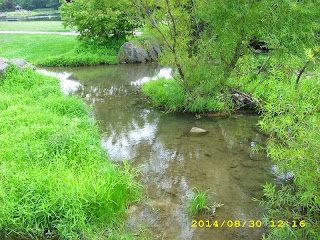The Town Of Gerrardstown, WV

Gerrardstown Town Historical Marker
Source: Debra Allen

Historical PackHorse Road
Source: Debra Allen

Mills Gap at the top of North Mountain where Route 51 (Historical Pack Horse Road), Route 45 (Apple Harvest Drive) and Route 20 meet.
Source: Debra Allen
This is the quaint town that I live in. It is located at the foot of North Mountain and also just on the other side of the mountain in Berkeley County, West Virginia. I live on the other side of North Mountain.
Originally Gerrardstown was named Middletown by german immigrant by the name of John Mills, Jr. in 1787.
During the Civil War many things changed for this small town. In 1863 the states split up from Virginia into West Virginia.
There are two main mountains here, North Mountain and Apple Pie Ridge. Apple Pie Ridge runs parallel with North Mountain. Apple Pie Ridge is named such for the many orchards that adorn the mountain sides. The soil was rich and fertile and that brought many farmers here. We have many orchards that grow many varieties of apples and peaches. You will see many Cattle and Horse farms and also a few with Goats. One of the local farm market is now raising Buffalo, Steer, Goats, Pigs along with the huge variety of apples, berries, pumpkins and other fruits and vegetables.
One of the earliest roads that was made is Pack Horse Road, and the older part is still partially there, (picture on right). It is now Route 51 that starts from Charlestown. WV and continues through Gerrardstown, over the top of the mountain named Mills Gap and down into Back Creek Valley.
North Mountain at Gerrardstown and Mills Gap.

East of North Mountain. Route 51 runs along the side of that mountain to the gap on the right of it where it meets Route 45 and Route 20.
Source: Debra Allen
A Legend About Some Gold?
Legend has it that two men in Braddock's Army had a couple of payloads of gold they were carrying. They decided to bury it because of an impending Indian Raid and the thought that they marked the area pretty well. Well when things calmed down and they came back a few years later the area was quite different and the never found that stash of gold. During the French and Indian War there were lots of skirmishes and raids in the area and it was difficult to stay there. On one occasion, at the last Indian Massacre, the Indians killed many and took a few to be sold as slaves. One woman was sold to a Canadian trader by the name of Jean Baptiste Plata. He fell in love with her, brought her back to Middletown (which is now Gerrardstown) married her. Her brother, George, killed him shortly after the wedding and she became very ill. After ten years she married William Cleery and they moved to Morgantown. Her name was Isabella Stockton.
Hays-Gerrard House, First Baptist Minister
John Gerrard House
John Hays and family were the first baptist settlers to come to live in the Gerrardstown area in1743.

John Hays was built his first house in Gerrardstown and then Reverend John Gerrards bought it, used it as a home and a church. It is still there.
Source: Debra Allen
The first Baptist preacher was Reverend John Gerrard. He acquired much land from Lord Fairfax and bought the John Hays house hence the name Hays-Gerrard house.
He built a big plantation and later sold it to his son, David. David then platted out the town and it did prosper a great deal. David changed the town's name from Middletown to Gerrardstown in 1784. It has been that name ever since.
***An interesting note about this historical house is there there are drawers under all the windows.
The Corner Store in Gerrardstown WV Excerpt from "The Gerardstown times." (Gerardstown [i.e. Gerrardstown] W. Va.) 1871-1905
The Corner Grocery Store

The Corner Store
Source: Debra Allen
It is on the corner of Mountain Street (now Route 51) and Congress Street (now Virginia Line Road). This store originally had 2 stories. It was torn down and this small store was built in it's place in 1845 and changed owners in 1867 and the new owner did not sell as wide a range of goods as the original owner.
The original name was Then Corner Store, then became the "Cheap Store" but eventually became The Corner Store again. It has changed owners a couple of time in the last 10 years.
During it's first phase when it was a 2 story building the Masonic Lodge held their meetings in the 2nd story of the store. The first newspaper was published there in Gerrardstown in that 2nd story building. The name of the newspaper was "The Gerrardstown Times" and was published in 1870.
Churches of Gerrardstown
Methodist Churches of Gerrardstown

Apple Chapel was originally Methodist Episcopal Church
(Southern)
Source: Debra Allen
Apple Chapel was renovated in 2008. Originally it was The Methodist Episcopal Church on the southern corner behind the Corner Store. During the Civil War the church members were divided on the different sides of the war and the new church formed leaving this one unfinished. That was until someone decided to finish it in all it's beautiful handwork and splendor and named it Apple Chapel. Occasionally there will be an event or meeting

This used to be the northern Methodist Episcopal Church.
Source: Debra Allen
 The Presbyterians arrived in Gerrardstown in 1794, but it was not until 1797 when they started having regular service. That was when Reverend Joseph Glass came. The cemetery and the church are a Historical Landmark. This is not the original church. This one was built in 1892 after two other churches were built. The second one was deemed unsound and then they built this new one that still stands and is in use today.
The Presbyterians arrived in Gerrardstown in 1794, but it was not until 1797 when they started having regular service. That was when Reverend Joseph Glass came. The cemetery and the church are a Historical Landmark. This is not the original church. This one was built in 1892 after two other churches were built. The second one was deemed unsound and then they built this new one that still stands and is in use today. The Methodists were the last denomination to settle in Gerrardstown. The first settlers were Baptists. The Methodists would have their services with the Presbyterians until this church was being built in the year 1833. The new church was built on Mountain Road in 1957. It still stands and is still in use.
The South and Northern Methodist spilt in the Civil War along the political lines of the state. Among other churches there were Lutheran and several other reformation churches. None of them are standing today. What is left of them is just the Lutheran Cemetery.
***Historical Note: President Lincoln's bodyguard is buried in this cemetery.
The Earl McCormick House

The Earl McCormick House 2013
Source: Debra Allen
This house is a house of add ons because each owner would add a section onto the existing house. The original is thought to be built around 1822. The two most noted additions were made in 1905 and 1920. The picture that I took here is 2013. You can see the many additions on the outside. On the inside there is a large hall in the center that has a gorgeous spiral staircase in it. I am not sure what is left in the ten room house because the current owners did some upgrading in the last three years. This house has had many owners in it's time but it got the name The McCormick house because they were the occupants that lived there the longest.
The James Bell House
The James Bell House a.k.a The Tavern

The James Bell House 2012
Source: Debra Allen
This is the only house that is still standing that was used as a tavern and Inn in Gerrardstown. It was bought by Mr. James Bell in 1796. The previous owner was Justus Gerrard who bought it from Daniel Thomas.
The original owner was Jesse and Sarah Payne. The original part of the log cabin was one room with a second story. The bottom was divided into four rooms and had 2 fireplaces. Early in the 19th century was when it was used on the bottom level as an Inn and Tavern. It was expanded and later was used as an antique shop, a pool house and currently it is a private residence.
There are several other buildings on this piece of property. Some are still standing and some have fallen apart. The most notable one is the building behind this one that was used as a residence, a wagon makers and a harness shop. Another house sit behind this house and is a log home used as a smokehouse and the original hardware is still there and intact.
There were a couple of other taverns and Inns but there isn't much information about them anymore. Too bad they do not have anything in this town anymore. There used to be a Bed and Breakfast and we did have family stay in it one night but it has since been sold and is now a private residence,
Wiest Store
Just in the last two years the antique store owner had moved everything out and closed it up.
 It was built in 1854 as a commercial property. The glass windows in the front used to be a porch area. It was built by Phillip Jacob Wiest who arrived in Gerrardstown in the year 1852. He had a few occupations as he was a farmer, a cabinet maker and an undertaker. It was like the stores that you see in old westerns and like on "Little House On The Prairie" with everything from groceries, equestrian things to fabrics.
It was built in 1854 as a commercial property. The glass windows in the front used to be a porch area. It was built by Phillip Jacob Wiest who arrived in Gerrardstown in the year 1852. He had a few occupations as he was a farmer, a cabinet maker and an undertaker. It was like the stores that you see in old westerns and like on "Little House On The Prairie" with everything from groceries, equestrian things to fabrics. Eventually Phillip's son, John, took over running the grocery store part and then later the entire business His father continued the undertaking business and made caskets in a building on the back of the property.
This store was operational for 124 years. Records showed that they used a bartering system for those who needed caskets to bury their loved ones.
My husband and I were in that building a few years ago when it was an antique shop. The floors were wooden, not like the kind or feel like they are today. There was a large staircase that in the back of the building. I definitely took you back in time as you walked around the building.
Sources and Other Related Information
"The Berkeley Journal" that was written in 1991 by the Berkeley County Historical Society.
----------------------------------------------------------------
© Debra K. Allen a.k.a Lady Guinevere
I researched and wrote this article. Please do not copy and paste any part of this article, picture included for your own use. I will find you and report you for stealing. It is my right to change any information therein at any time and/or change the location of my article.
.jpg)


.jpg)
.jpg)
.jpg)
.jpg)

.jpg)
.jpg)